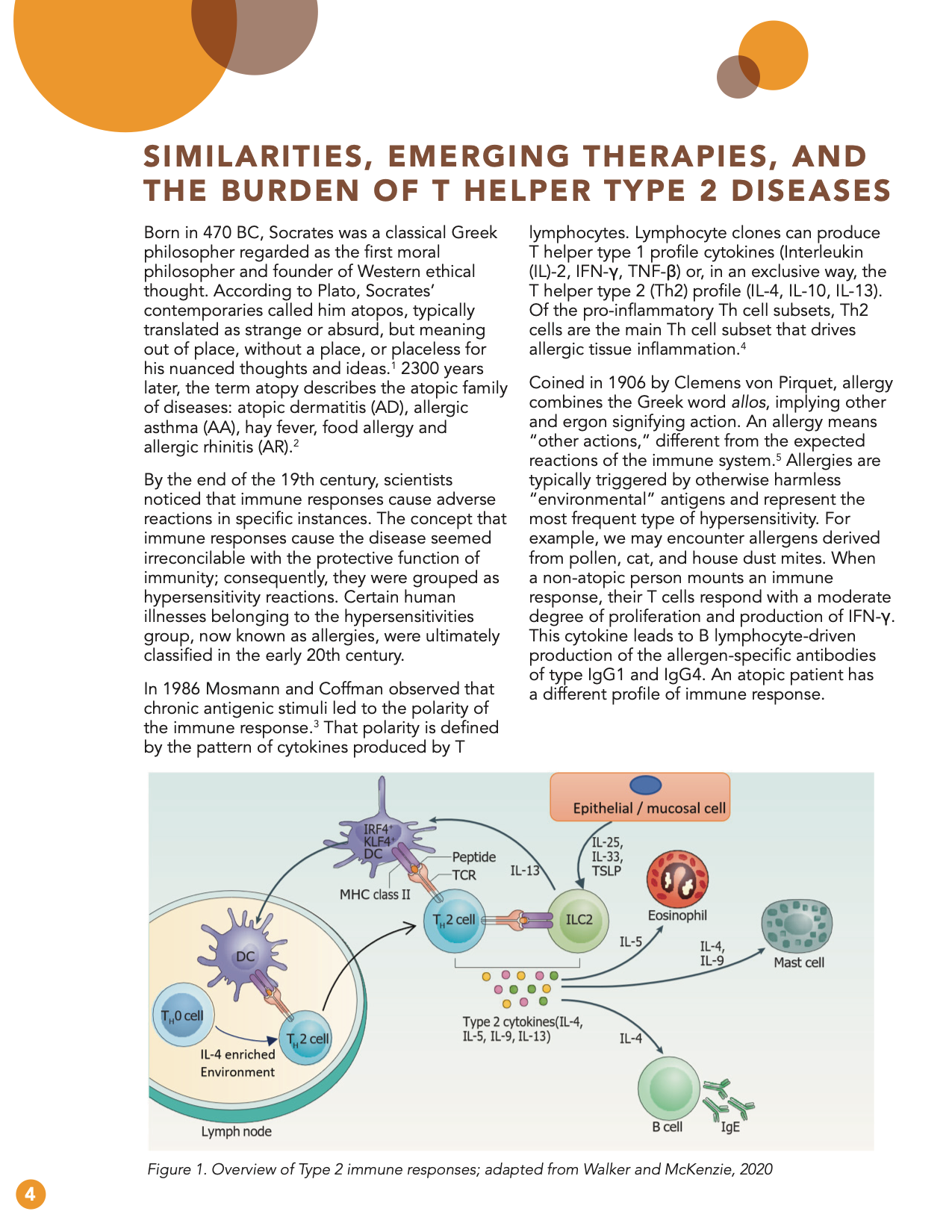Similarities, Emerging Therapies, and the Burden of T Help Type 2 Diseases
DOI:
https://doi.org/10.58931/cait.2021.1s1144Abstract
Born in 470 BC, Socrates was a classical Greek philosopher regarded as the first moral philosopher and founder of Western ethical thought. According to Plato, Socrates’ contemporaries called him atopos, typically translated as strange or absurd, but meaning out of place, without a place, or placeless for his nuanced thoughts and ideas.1 2300 years later, the term atopy describes the atopic family of diseases: atopic dermatitis (AD), allergic asthma (AA), hay fever, food allergy and allergic rhinitis (AR). By the end of the 19th century, scientists noticed that immune responses cause adverse reactions in specific instances. The concept that immune responses cause the disease seemed irreconcilable with the protective function of immunity; consequently, they were grouped as hypersensitivity reactions. Certain human illnesses belonging to the hypersensitivities group, now known as allergies, were ultimately classified in the early 20th century.
References
Kennerly M. Socrates Ex Situ. Advances in the History of Rhetoric. 2017;20(2):196-208. doi:10.1080/15362426.2017.1327278
Aw M, Penn J, Gauvreau GM, Lima H, Sehmi R. Atopic March: Collegium Internationale Allergologicum Update 2020. Review. International Archives of Allergy and Immunology. 2020;181(1):1-10. doi:10.1159/000502958
Mosmann TR, Cherwinski H, Bond MW, Giedlin MA, Coffman RL. Two types of murine helper T cell clone. I. Definition according to profiles of lymphokine activities and secreted proteins. The Journal of Immunology. 1986;136(7):2348- 2357.
Walker JA, McKenzie ANJ. TH2 cell development and function. Nature Reviews Immunology. 2018;18(2):121-133. doi:10.1038/nri.2017.118
Shulman ST. Clemens von Pirquet: A Remarkable Life and Career. Journal of the Pediatric Infectious Diseases Society. 2016:piw063. doi:10.1093/jpids/piw063
Stark JM, Tibbitt CA, Coquet JM. The Metabolic Requirements of Th2 Cell Differentiation. Frontiers in Immunology. 2019;10 doi:10.3389/fimmu.2019.02318
Weidinger S, Novak N. Atopic dermatitis. Lancet. 2016;387:1109-22. doi:10.1016/S0140-6736(15)00149-X
Global Initiative for Asthma (GINA). Global strategy for asthma management and prevention. 2019. Available from: https://ginasthma.org.
Global Initiative for Chronic Obstructive Lung Disease (GOLD). Global strategy for the diagnosis, management, and prevention of Chronic Obstructive Pulmonary Disease: 2019 report. Nov 2018. Available from: https://goldcopd.org/archived-reports.
Hill DA, Spergel JM. The immunologic mechanisms of eosinophilic esophagitis. Curr Allergy Asthma Rep. 2016 Feb;16(2):9. doi:10.1007/s11882-015-0592-3
Schleimer RP. Immunopathogenesis of chronic rhinosinusitis and nasal polyposis. Annu Rev Pathol. 2017 Jan 24;12:331-357. doi:10.1146/annurev-pathol-052016-100401
Bertschi NL, Bazzini C, Schlapbach C. The Concept of Pathogenic TH2 Cells: Collegium Internationale Allergologicum Update 2021. International Archives of Allergy and Immunology. 2021;182(5):365-380. doi:10.1159/000515144
Williamson PA, Vaidyanathan S, Clearie K, Barnes M, Lipworth BJ. Airway dysfunction in nasal polyposis: a spectrum of asthmatic disease? Clinical & Experimental Allergy. 2011;41(10):1379-1385. doi:10.1111/j.1365-2222.2011.03793.x
Zhang N, Van Zele T, Perez-Novo C, et al. Different types of T-effector cells orchestrate mucosal inflammation in chronic sinus disease. J Allergy Clin Immunol. 2008;122(5):961-968. doi:10.1016/j.jaci.2008.07.008
Bachert C, Han JK, Desrosiers M, Hellings PW, Amin N, et al. Efficacy and safety of dupilumab in patients with severe chronic rhinosinusitis with nasal polyps (LIBERTY NP SINUS-24 and LIBERTY NP SINUS-52): results from two multicentre, randomised, double-blind, placebo-controlled, parallel- group phase 3 trials. Lancet. 2019 Nov 2;394(10209):1638-50. doi:10.1016/S0140-6736(19)31881-1
Seumois G, Ramírez-Suástegui C, Schmiedel BJ, et al. Single-cell transcriptomic analysis of allergen-specific T cells in allergy and asthma. Science Immunology. 2020;5(48):eaba6087. doi:10.1126/sciimmunol.aba6087
Corren J. New Targeted Therapies for Uncontrolled Asthma. J Allergy Clin Immunol. 2019;7(5):1394-1403. doi:10.1016/j. jaip.2019.03.022
Islam SA, Chang DS, Colvin RA, et al. Mouse CCL8, a CCR8 agonist, promotes atopic dermatitis by recruiting IL-5+ TH2 cells. Nature Immunology. 2011;12(2):167-177. doi:10.1038/ni.1984
Hijnen D, De Bruin-Weller M, Oosting B, et al. Serum thymus and activation-regulated chemokine (TARC) and cutaneous T cell-attracting chemokine (CTACK) levels in allergic diseases: TARC and CTACK are disease-specific markers for atopic dermatitis. J Allergy Clin Immunol. 2004;113:334-40.
Weidinger S, Beck LA, Bieber T, Kabashima K, Irvine AD. Atopic dermatitis. Nature Reviews Disease Primers. 2018;4(1). doi:10.1038/s41572-018-0001-z
Damsky W, King BA. JAK inhibitors in dermatology: The promise of a new drug class. Journal of the American Academy of Dermatology. 2017;76(4):736- 744. doi:10.1016/j.jaad.2016.12.005
AJMC Perspectives. Evolving Treatment Strategies in Type 2 Inflammatory Disease. Perspectives in Type 2 Inflammation. Jun 2019. Available from: https://www.ajmc.com/view/evolving-treatment-strategies-in-type-2-inflammatory-disease.
Mitson-Salazar A, Prussin C. Pathogenic Effector Th2 Cells in Allergic Eosinophilic Inflammatory Disease. Front Med. 2017;4. doi:10.3389/fmed.2017.00165
Bruton K, Spill P, Vohra S, et al. Interrupting reactivation of immunologic memory diverts the allergic response and prevents anaphylaxis. J Allergy Clin Immunol. 2021;147(4):1381-1392. doi:10.1016/j.jaci.2020.11.042
Eskian M, Khorasanizadeh M, Assa’Ad AH, Rezaei N. Monoclonal Antibodies for Treatment of Eosinophilic Esophagitis. Clin Rev Allergy Immunol. 2018;55(1):88-98. doi:10.1007/s12016-017-8659-7
Hirano I, Dellon ES, Hamilton JD, et al. Efficacy of Dupilumab in a Phase 2 Randomized Trial of Adults With Active Eosinophilic Esophagitis. Gastroenterology. 2020;158(1):111-122.e10. doi:10.1053/j.gastro.2019.09.042
Gupta R, Sheikh A, Strachan DP, Anderson HR. Burden of allergic disease in the UK: secondary analyses of national databases. Clin Exp Allergy. 2004 Apr;34(4):520-6. doi:10.1111/j.1365-2222.2004.1935.x
Paller A, Jaworski JC, Simpson EL, et al. Major Comorbidities of Atopic Dermatitis: Beyond Allergic Disorders. Am J Clin Dermatol. 2018;19(6):821-838. doi:10.1007/s40257-018-0383-4
Irvine AD, Mina-Osorio P. Disease trajectories in childhood atopic dermatitis: an update and practitioner’s guide. Br J Dermatol. 2019 Nov;181(5):895-906. doi:10.1111/bjd.17766
Belgrave DCM, Granell R, Simpson A, Guiver J, Bishop C, et al. Developmental profiles of eczema, wheeze, and rhinitis: two population-based birth cohort studies. PLoS Med. 2014 Oct 21;11(10):e1001748. doi:10.1371/journal.pmed.1001748
Bergmann RL, Wahn U, Bergmann KE. The allergy march: from food to pollen. Environmental Toxicology and Pharmacology. 1997;4(1-2):79-83. doi:10.1016/ s1382-6689(97)10045-x

